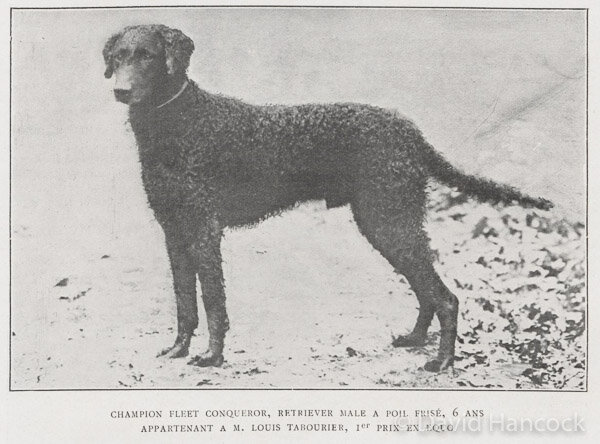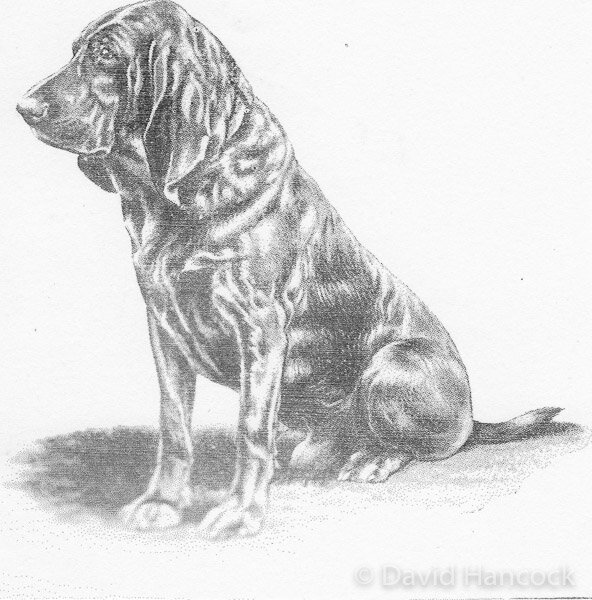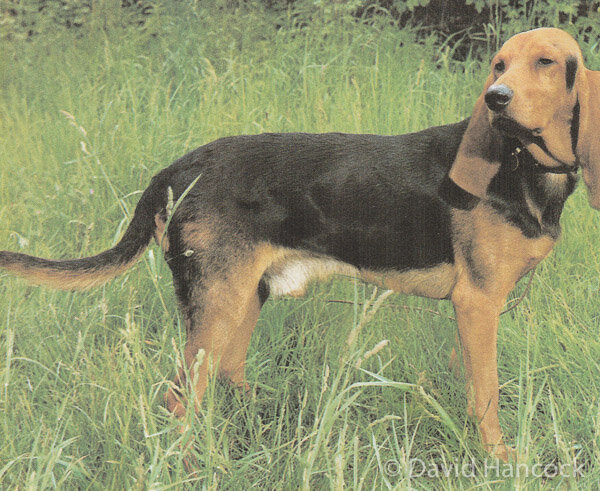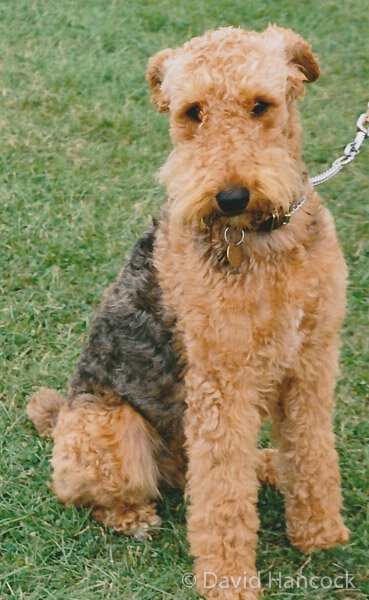1148
REVERTING TO TYPE
By David Hancock
Many breeders of pedigree dogs in Britain put 'type' at the top of their list when it comes to placing, in order of priority, their breeding criteria. Despite that, it is disappointing to note just how many breeds have lost their essential 'typiness' over the years. Breeds like the Bull Terrier, the Newfoundland, the Shetland Sheepdog, the Bulldog, the Bloodhound, the Rough Collie, the St Bernard, the Mastiff and the Dachshund get less and less like the early specimens of the breed with each generation. On the other hand, breeds like the Border Terrier, the Deerhound, the Curly-coated Retriever, the Dalmatian, the Schipperke and the Pug seem able to resist human whim and retain the truly traditional look of the breed. Perhaps their breed clubs insist on true type ahead of breeder whim. Exaggerations exaggerating themselves play a part, as the Basset Hound illustrates. Unwise Breed Standards, or word-pictures for a breed, play an important role too.
For me, there are two very simple criteria to be brought to bear here. Firstly, if you admire a breed and respect its ancestry, why make it look like something different? To do so is an entirely irrational act. Secondly, if you love dogs and one breed above all others, how can you possibly justify breeding dogs of that chosen breed with an anatomy that is not only quite unlike that of their ancestors but one that threatens their health and well-being? To do so lacks any real affection, merely indicates self-interest and the absence of any real empathy with subject creatures.
Physical and mental soundness are key ingredients of type. Our ancestors, who pioneered these magnificent breeds we own in our lifetime, knew that the correct type brought soundness with it. Were the early Newfoundlands, used by wildfowlers like the celebrated Colonel Hawker in the most testing conditions of terrain and weather, unsound? How long would a Bulldog last in the bull-baiting ring if it were unsound? Seeking remedy is not entirely straightforward since the worship of pure-breeding rules. The ugly, unsound, show-ring Bulldog could benefit from the introduction of outside blood, especially from the far sounder, unexaggerated, healthier Sussex and Dorset Olde Tyme Bulldogges that I see at ‘unsanctioned’ or ‘alternative’ dog shows. They resemble the true type of Bulldog that was depicted in so many old paintings of the breed.
Why did the hunting Basset fraternity outcross to the Harrier when they realised that soundness and functional type, as well as field performance, were in peril in their breed? And why did Brough, the pioneer Bloodhound breeder, advocate an outcross in every fifth generation? The maintenance of type and the pursuit of excellence must never be perverted by the seeking of purely cosmetic appeal in one or two generations of owners. The Mastiff breeders lost their way over a century ago, perpetuating the result of the alien blood introduced in the nineteenth century, making the breed more like Alpine Mastiffs than the once-admired English one. Again, I see far better Mastiffs away from the show ring, the results of inspired cross-breeding by knowledgeable owners. The dogmatic pursuit of pure-breeding is admirable when a breed is in its infancy but not when it’s on its death-bed!
The old breeders, so many of whom were livestock breeders too, knew that once you got the 'type' there, soundness and physical excellence accompanied it. But when you lose type, you more or less lose the breed too. Early in the last century, Lt Col GH Badcock was writing, in his "Disobedient Dogs": "While there are, of course, a host of useful breeders, there are also a multitude of useless ones. These latter simply look on dogs as a commercial proposition...this spirit of commercialism has a disastrous result as regards what is known as type in dogs." Even a cursory glance around the show benches of today illustrates the sad accuracy of Badcock's words. That simply admirable breed, the Newfoundland, is now being bred to look like a mountain dog, with a lumbering gait actually being desired. Colonel Hawker, the best shot of his day, wrote in glowing terms in his 1814 diary of the Newfoundland as a retriever, but "not the heavy brute that so often and so commonly disgraces the name of the Newfoundland dog." It is distressing to note that in the FCI grouping of dog breeds, this distinguished breed - once known as the Great Retriever and father of our modern retriever breeds, is in Group 2: Pinscher, Schnauzer and Mountain Dogs. Is it surprising that this remarkable water dog is now assuming the anatomy of a Leonberger or a St Bernard - with the inevitable loss of type?
Why cannot the fanciers of this breed show respect for the outstanding service to man of their fine breed? This applies too to Bloodhound breeders. I was informed by an enthusiastic Bloodhound exhibitor at Crufts some years ago that the excessive loose skin or cowl was meant to cover the hound's eyes, when tracking, so that it had to use its nose! He was nonplussed when I showed him a photograph of perhaps the most famous tracking Bloodhound of all time, Druid and Champion Nestor, that clearly showed no excessive skin at all. The pedigree breed badly needs an outcross to a pack Bloodhound or a comparable foreign breed, such as the Jura Hound or the working scenthounds further east, such as the Gonzy Polski or the Transylvanian Mountain Hound, if true type is to be restored. The exaggerations in the show Bloodhounds harm the dogs!
I am a Bull Terrier fan but I have no wish to own a dog with a rugger-ball for a head. How can such a feature be justified? It is not historically correct. I meet would-be Bull Terrier owners quite regularly who will not proceed with a purchase whilst this strange head is a breed feature. Twenty years ago when I wrote of my concern over the loss of true type in the head of this splendid breed, the wealthy owner of a large kennel wrote a patronising response, not answering the points being made but defending his personal whim. That perhaps illustrates very aptly the point that breeders and breed clubs can at times lose their way and firm guardianship at Kennel Club level is vital in perpetuating true type in our precious breeds. I see so-called ‘Irish Staffies’ that step straight out of old photos of Bull Terriers – that tells you a great deal about the disinclination of both fanciers and clubs to respect true type. Some of the best dogs that I see at World Dog Shows are American Staffordshire Terriers – what a valuable outcross for our Bull Terriers they would make. But forget the needs of the breed, the fancies of the show breeders come first! The best Bull Terrier I have seen for some years was Lyndon Ingles’s Hinks, a real throwback to the genuine stock.
I am not advocating for one moment that we only breed pedigree dogs to look like their distant ancestors. The founding dogs in a number of breeds were physically quite dreadful and skillful breeders have improved quality discernibly since those early days. But type can be lost in any breed at any time if breed clubs are not collectively vigilant. It is never a case of type perpetuating itself; it has to be consciously sought. Genetic tendencies have to be countered if they lead breeds away from the essence of the breed. The short face for example is dominant and in breeds like the Bullmastiff, breeders have to be watchful that muzzles don't become untypically short and giant fawn or brindle Bulldogs result. The right head on a Bullmastiff makes the breed. The gamekeepers’ night-dog type should be decisive in this breed.
Basset Hounds and Cocker Spaniels now have ears which are untypically too long. Rough Collies and Shetland Sheepdogs now have coats which are untypically too heavy. Dachshunds' legs are now untypical because they are too short. Stockard concluded many years ago that short legs were genetically dominant. At what stage do we acknowledge that they have become too short in a breed, too short that is for the good of the dog rather than the pocket of the breeder? We are steadily losing the true Labrador head. Our Airedales sadly seem to get soppier each year - how I miss the gameness and spirit once such an attractive feature of this excellent breed. But if you raise these points, as matters of sincere interest and genuine concern with breeders at shows or seminars you get a very disappointing reaction. This can vary from "we like what we've got, so what's the problem?" to downright resentment. To me such reactions indicate a lack of any real affection for a breed. It is foolish to regard any dog registered with the KC as a purebred product as having true type just because it is a registered pedigree dog. Type in any breed of dog is far more subtle and a lot more elusive than that. For me dogs with the genuine look of their breed are always to be preferred to untypical specimens with "papers".
Is a German Shepherd Dog with a roach back, hyper-angulation in its hindquarters and a lack of substance, with two show ring wins and KC registration to be preferred to an upstanding, well-boned and symmetrically built dog with a level topline but no papers? Contemporary GSD breeders seem to have lost their way and it's going to take decades to restore true type to this quite outstanding breed. I wholeheartedly agree with Lady Malpas, who wrote a few years ago to one of the dog papers: "There can be no justification for any attempt, accidental or intentional, to produce different types of German shepherd." I also support the view of a GSD breed correspondent who wrote: "What has happened to this noble breed? I was brought up in the school that had as a pattern dogs like Ch. Fenton of Kentwood, Ch. Sergeant of Rozavel and other famous dogs of similar type. My mentors told me that a good Alsatian could carry a glass of water on its back without spilling when moving..." For me, the old Picardy and Novem kennels exemplified all that was distinctive about this once-splendid breed.
The service to man of the German Shepherd Dog is difficult for any other breed to match. I have seen them at work and witnessed their versatility in nearly twenty different countries. I had always considered their breed type to be fixed. Unlike manufactured breeds like the Dobermann and the Bullmastiff, there is no risk of a strong prototypal ancestor-breed like the Greyhound or the Bulldog manifesting itself. Any breeder who tampers with a breed type long established, long accepted and long proven able to produce an intelligent, healthy, biddable dog is a dangerous, misguided maverick who should be halted in his tracks. In any breed of pedigree dog, it only takes one determined breeder with more money than sense to promote his concept, or a dominant clique to gain ascendancy for true type to be threatened. Breeds don't just lose type; breeders lose their way. But who lets them? Two hundred years ago, Edmund Burke was writing: "An event has happened, upon which it is difficult to speak, and impossible to be silent." Those who love dogs for what they are, as opposed to what they're worth, must always find it impossible to be silent. In this way gratitude is shown to those who handed our precious breeds of dog down to us. It demonstrates too an awareness of our duty to those who come after us. If you care - speak up!





























